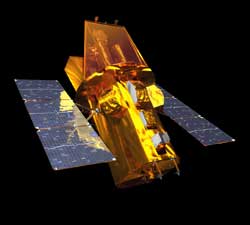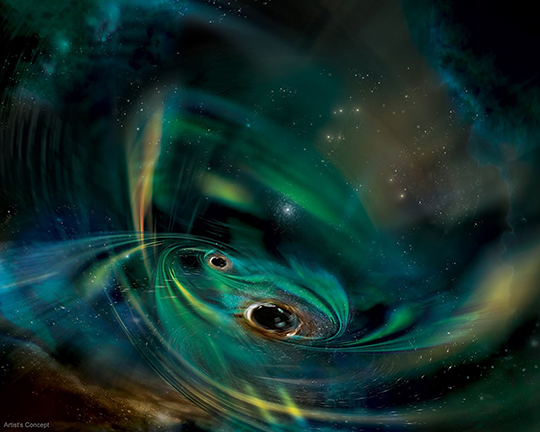The Neil Gehrels Swift Observatory
 Gamma-ray bursts (GRBs) are the most powerful explosions the Universe has seen since the Big Bang. They occur approximately once per day and are brief, but intense, flashes of gamma radiation. They come from all different directions of the sky and last from a few milliseconds to a few hundred seconds. So far scientists do not know what causes them. Do they signal the birth of a black hole in a massive stellar explosion? Are they the product of the collision of two neutron stars? Or is it some other exotic phenomenon that causes these bursts?
Gamma-ray bursts (GRBs) are the most powerful explosions the Universe has seen since the Big Bang. They occur approximately once per day and are brief, but intense, flashes of gamma radiation. They come from all different directions of the sky and last from a few milliseconds to a few hundred seconds. So far scientists do not know what causes them. Do they signal the birth of a black hole in a massive stellar explosion? Are they the product of the collision of two neutron stars? Or is it some other exotic phenomenon that causes these bursts?
With Swift, a NASA mission with international participation, scientists have a tool dedicated to answering these questions and solving the gamma-ray burst mystery. Its three instruments give scientists the ability to scrutinize gamma-ray bursts like never before. Within seconds of detecting a burst, Swift relays its location to ground stations, allowing both ground-based and space-based telescopes around the world the opportunity to observe the burst's afterglow. Swift is part of NASA's medium explorer (MIDEX) program and was launched into a low-Earth orbit on a Delta 7320 rocket on November 20, 2004. The Principal Investigator is Dr. Brad Cenko (NASA-GSFC).
» NASA Release
» En Espanol
» Multimedia
Swift Operations Status
Operations are nominal.
Swift Resources
» GRB, BA, & TOO Contact Information» BAT Transient Lightcurves
» Swift Supernovae
» Observing Schedule
» Journal Papers Related to Swift
» Swift Press Release Image Archive
» Swift User's Group (SUG)
» Swift Mission Participants
Latest Swift GRBs
Latest Swift News
NASA's Swift Reaches 20th Anniversary in Improved Pointing Mode
After two decades in space, NASA's Neil Gehrels Swift Observatory is performing better than ever thanks to a new operational strategy implemented earlier this year. The spacecraft has made great scientific strides in the years since scientists dreamed up a new way to explore gamma-ray bursts, the most powerful explosions in the universe.
+ Learn More
NASA's Swift Studies Gas-Churning Monster Black Holes
Scientists using observations from NASA's Neil Gehrels Swift Observatory have discovered, for the first time, the signal from a pair of monster black holes disrupting a cloud of gas in the center of a galaxy.
+ Learn More
NASA-UMBC Interaction Days
Sep 9, Sep 16, Sep 30, 2024
We are excited to announce three days of NASA-UMBC interaction, where senior scientists and technologists from NASA Goddard Space Flight Center will give lectures on cutting edge science and technology advancements and discuss opportunities for students and faculty to engage with Goddard scientists and engineers.
+ Learn More
If you're a Swift Team member looking for the Team site, try:
NOTE: You will need your Team username and password to access this site.



